| 1Introduction | 2Serv. Mgmt. | 3Principles | 4Processes | 5Activities | 6Organization | 7Consideration | 8Implementation | 9Issues | AAppendeces |
| 5.1COMMUNICATIONS/COMMITMENT | 5.2ORG/STAKEHOLDER | 5.3STAKEHOLDER MGMT |
![]()
5.1 MANAGING COMMUNICATIONS AND COMMITMENT
Communication is central to any Service Transition change process. The greater the change, the greater the need for clear communication about the reasons and rationale behind it, the benefits expected, the plans for its implementation and its proposed effects. Communication' need to be targeted at the right audience and clearly communicate the messages and benefits consistently. If total honesty is not possible, admit this and explain why it is not possible, e.g. for security reasons. Understanding people's commitment is important before planning the communications.
The best use of time is to concentrate on those people who are between the two extremes, e.g. stakeholders capable of understanding and welcoming the transition. Although this seems obvious, it is common for people to spend too much time talking to those who are sympathetic to an idea, since this is easier and delivers the positive feedback that people tend to require to feed their confidence and job satisfaction. At this stage the Service Transition team needs to be intuitive to its audience.
The Service Transition team will soon become familiar with the need to change attitudes and the operation of converting culture. For them it is a routine task, holding no threat. It can be hard to remember that, for those affected by the change, it is not a usual situation and they will be worried and a shared understanding will help greatly.
Example: Emergency room syndromeA hospital doctor, working in the emergency room will be used to seeing typical patients presenting typical symptoms. Thus, at 3 a.m., the doctor, possibly after very long hours and while grabbing some well-deserved rest, is called to see a patient who is, in their mind, just yet another middle-aged man with severe chest pains. Although routine and unexciting to the doctor, nonetheless a good doctor will remember that it is the first time this particular man has nearly died from a heart attack. The doctor will not let their familiarity with the situation and their lack of enthusiasm be evident. Instead, they will match their manner to that of the patient and treat the situation with the urgency and importance the customer expects. |
It is important the Service Transition team members are capable of understanding the impact of their work on others, and therefore tailoring their own approach to the stakeholder audience. Ultimately, the Service Transition team's goal is to build enthusiasm and commitment to the change, while ensuring that all stakeholders are clear about how the changes will impact themselves, and what will be expected of them in the coming months. Clear two-way communication channels will help employees feel their feedback and ideas are valued.
Stakeholder management can consume significant amounts of labour, with up to 50% of staff effort often consumed by this task during significant organizational change periods.
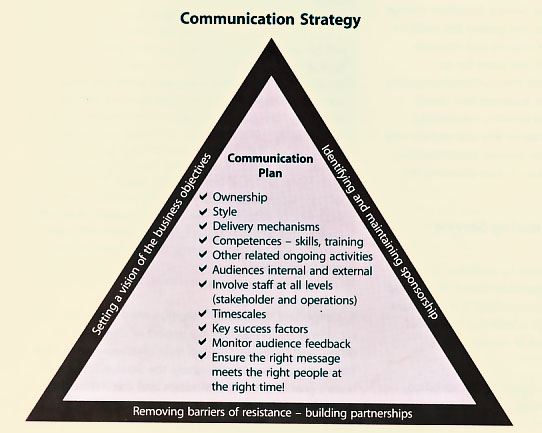
|
| Figure 5.1 Example of communications strategy and plan contents |
When announcing information during a Service Transition change, the following considerations should be made for each statement you need to communicate:
Figure 5.1 shows an overview of the key elements for consideration when planning for effective communication. To ensure that a communication strategy is effective, surveys and measures should be determined for regular monitoring. This will take the form of feedback from those people that have had any communication. It should also include how people are feeling on their 'change cycle' to establish that the target is right. At this point there may be individuals that are identified that should have more personal contact from the Service Transition Team in order for them to achieve an acceptable state.
To obtain an appreciation of the sequence of events, a communication path diagram such as the one shown in Figure 5.2 helps the planning of the communication process.
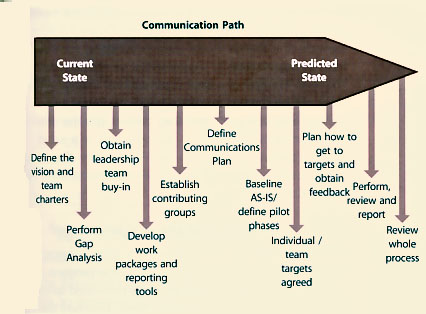
|
| Figure 5.2 Example communication path |
Using multiple communication means will help understanding of the overall message. Common media types include:
Example: The service deskIt is important to understand the dynamics of the service desk operation. Generally this group of staff will be doing shift working, with hours covering early mornings, evenings and weekends. They also tend to be one of the largest groups within the support operation, so it is particularly important that they get a consistent message during communication about the change. Some of the communication means that would be appropriate for this audience could be as follows.Taking selected key people from the service desk such as the shift leaders, and team leaders to hear the large workshop brief. This will ensure that a large enough group have heard the full brief, and they will then be in a position to debrief their smaller teams. Members of the Service Transition team could then attend the individual team meetings to support the team leader as they conduct the debrief, and answer any questions. Using reinforcement memos, this ensures that the service desk staff feel that they are being communicated to by the senior stakeholder rather than being left out. It will also help at the point that they are about to take over any support from the Service Transition changes. This is also a cost-effective means of keeping a large group of people up to date and engaged in the process. |
Models help to communicate what people should expect for each service or each type of change. Figure 5.3 is an example of a change model used to transition services from an organization to a commercial service provider. This is an example of a total organizational change where there will be changes in management, processes and staffing, although many staff may transfer into the new service provider organization. Having access to a set of service, change and transition models in a form that is easy to communicate will help to set expectations during the Service Transition.

| |||
|
|
|
|
| Figure 5.3 Example of Service Transition steps for outsourcing | |||
| The essential characteristics of the job | What the worker gets from them | The result if all these job characteristics are present |
| Feedback from the job | Knowledge of the actual results of work activities | High internal work motivation |
| Autonomy | Experienced responsibility for outcomes of work | |
| Skill variety Task identity Task significance | Experienced meaningfulness of the work | |
| Table 5.1 Job characteristics that motivate people | ||
![]()
5.2 MANAGING ORGANIZATION AND STAKEHOLDER CHANGE
Service Transition's basic role is, on the basis of agreed design, to implement a new or changed service, effectively making the organization different than it was before. For a change of any significance, this is delivering an organizational change, ranging from moving a few staff to work from new premises through to major alterations in the nature of business working, e.g. from face-to-face retail to web-based trading.
Change is an inevitable and important part of organizational development and growth. Change can occur in incremental phases or suddenly, affecting some or all of an organization, its people and its culture. Without change, progress does not happen.
Organizational change efforts fail or fall short of their goals because changes and transitions are not led, managed and monitored efficiently across the organization and throughout the change process. These gaps in key organizational activities often result in resistance, dissatisfaction and increased costs. Change is never easy; it usually takes longer than planned and creates barriers and resistance along the way. Effective leaders and managers understand the change process and plan and lead accordingly. Major negative impact can come from losing staff - disillusioned people leaving - which brings risks to the organization, e.g. loss of knowledge and lack of handover.
This section provides more detail about the involvement of Service Transition in managing organizational change. It includes assurance of the organization change products from Service Design, stakeholder management and communications and approaches to cope with change during transition.
The research on Change Management strongly suggests that without the support of people, change will not happen. Business managers and change agents must understand the emotional impact that change has on people and how to manage it accordingly. Much research has been done on the emotional impact of change. What this means is that failure to consider organizational change and how it affects people is a significant factor in causing transitions to fail. In order to facilitate the acceptance of change, it is important to understand the 'emotional stages' that a person needs to get through before acceptance. This is illustrated in Figure 5.4.
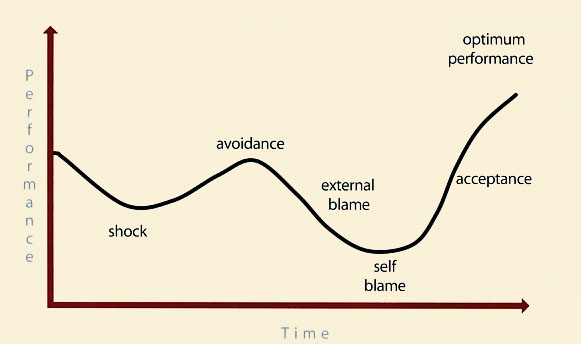
|
| Figure 5.4 The emotional cycle of change |
For all significant changes, individuals will go through this process. At first they enter into a degree of shock, before going into avoidance. This will often manifest itself in increased efficiency while the situation is denied. This is usually a rapid stage, at which point performance drops as people choose to 'shoot the messenger' and blame the change initiators and Service Transition team, followed by self-blame as insecurity and the threat of the situation is felt. Performance is now at its lowest. It follows that the quicker the Service Transition team can get individuals through the cycle, the shorter the timescales before acceptance and optimum performance. One can use the experience of those within the affected area to understand concerns, and the nature of resistance in order to communicate at the appropriate stages. This may often take considerable personal time of the Service Transition team, to listen to people's concerns, but ultimately will get individuals engaged and performing in as short a time as possible.
Appropriate communication through these stages of transition will drive the energy of individuals from low to high, obtaining involvement and generating a more positive attitude as the change takes place. As emphasized, this is a pattern followed by individuals, and different people will pass through these typical phases at different speeds, so understanding where individuals are on this curve and supporting and progressing them can be a significant resource commitment for Service Transition.
Although Service Transition is not accountable for the overall management of business and technical change the Service Transition process owner or manager is a key stakeholder and needs to be proactive in reporting issues and risks to the change leaders, e.g. when the volume of changes may impact Service Operation's ability to keep the services running.
Organizational adoption is a subset of Change Management practice. It typically happens at two levels: individual and organizational. It is important to understand the culture of the organizations and the people involved. This will often be quite diverse across different cultures, business units, geographies and including:
Cultural and organization assessment and change design are the responsibility of strategy and design. However, most significant Service Transitions will have an effect on working practices and so require a change in the behaviour and attitudes of many teams and stakeholder groups. Understanding the organizational change elements of a transition is therefore vital. The assessment of the likely risks and success is an important element of the transition as a whole. Service Transition will be involved early in the lifecycle to ensure that these aspects are assessed and incorporated into the design and build of the organizational change.
Service Transition must be actively involved in changing the mindsets of people across the lifecycle to ensure they are ready to play their role in Service Transition. These people will include:
Service Transition will focus on simple messages at any one time to ensure there is consistency in the implementation of the changes. For example, Service Transition would be interested in helping people to:
Service Design will perform the assessment of the capability and capacity of the IT organization to transition the new or changed services. Service Transition has a quality assurance role to check that the organization and stakeholders are ready for the change and it will raise any issues and risks related to organizational change that are identified, e.g. during testing, pilots, deployment and early life support.
Service Transition is also responsible for ensuring that the organizational change happens according to the plans, that the change is still relevant in current circumstances and that the organizational change delivers the predicted organization, capabilities and resources. This will involve checking that changes are being adopted, e.g. that a critical mass of customers, users and Service Operations staff accept the change and make a personal commitment to implementing it. Anecdotal evidence suggests that once a 'critical mass' of around 70% of affected people have accepted the change into their normal way of working the change can safely be held as established behaviour. If the adoption rate is lower then a significant chance exists that an organization might revert to the 'old ways'. The actual figure will be greatly influence by the degree of staff involvement with a particular change, e.g. a few key staff can deliver a disproportionately major influence for acceptance or rejection.
Achieving successful Service Transition requires organized, competent and well-motivated people to build, test, deploy and operate the service. Successful Service Transitions rely on changing the organization and people and it is important to focus on such aspects as competency assessment and development, recruiting, skills development, knowledge transfer, team building, process improvements and resource deployment. If there is a gap in capability then Service Transition will provide input into the relevant party, e.g. project management, Service Design, Continual Service
.
Organizational culture is the whole of the ideas, corporate values, beliefs, practices, and expectations about behaviour and daily customs that are shared by the employees in an organization. Culture can support an implementation or it can be the source of resistance.
When performing Service Transition activities it is important to gain an understanding of the type of culture currently existing in the organization and how this is likely to be affected by any proposed changes. Conversely, it is equally important to understand the effect current culture may have as a 'barrier' to realizing change. Examples of key questions to be posed to help identify culture are shown in Table 5.2. These questions are useful when reviewing the Service Strategy and Service Design deliverables.
| Cultural aspect | Question |
| Language | Is there a common language or shared language(s)? Does the language inhibit and reinforce boundaries or facilitate effective change and knowledge transfer? Is the organizational language style mostly formal or informal? |
| Change | Does the organization appear to resist change or is it constantly evolving? |
| Communication | What are the preferred modes of communication? What is the content and style of internal communications? Where does official and unofficial communication happen? Are communication channels open and democratic or closed and hierarchical? How is knowledge and experience shared? Are rumours/gossip prevalent? |
| Knowledge flow | How do people describe the way knowledge and information is transferred around the organization? How easy is it to find what you need to know, when you need it? How easy is it to find the right person with the right experience? |
| Communities | Are there identifiable 'communities' within the organization? Is there a community leader, e.g. problem management community leader? What is the structure and function of these communities? |
| Networks | Are an individual's networks well developed, on the whole? What kind of information is exchanged by these people? |
| Working environment | Does the working environment create the right conditions for knowledge transfer and integrated working, e.g. close proximity physically and/or electronic tools? How are desks configured? How are communal areas used? |
| History | How does the organization see its own history? Is it valued and used or quickly forgotten? How does the organization value past experiences, e.g. do people still refer back to their old company after a merger? |
| Meetings | Are meetings seen as productive? How are they managed? Are they effective? Does everyone feel safe to speak? How is opinion or criticism handled? How is output captured or taken forward? |
| Rewards and motivations | How are individuals/teams rewarded or recognized for sharing knowledge/information and experience? What motivates people in the organization? What else might be blocking engagement of an individual/team, e.g. other major change, major incident handling? |
| Time | What are individuals', teams' and the organizational attitudes to time, e.g. busy or relaxed; punctual, rigid and unchanging or flexible? |
| Table 5.2 Understanding the culture of the parties involved | |
As discussed in the Service Strategy publication, an organization's age and size affect its structure. During a Service Transition, changes in roles, processes and relationships must be made or problems will arise. Understanding the different phases of development of the stakeholder organizations helps Service Transition manage the stakeholders and users better.
In order to manage organization change it is important that the stakeholders and teams understand what is required and can answer these questions:
As part of quality assurance and implementation, the stakeholders and IT teams can be sampled to understand and clarify their expectations about these aspects.
An example of a RACI matrix for managing change during the service lifecycle that supports Service Transition activities is shown in Table 5.3. In many instances on the chart the 'R' for responsibility appears in more than one column. This is indicative of the hierarchical nature of the responsibility, with strategic, tactical and operational responsibilities being required and thus spreading across more than a single column. In these instances the lefthand occurrences are more managerial, the ones to the right focusing on delivery. Service Transition will check that organizational change products and services are fit for purpose. For large-scale changes, such as mergers and acquisitions and outsourcing, this will include validation of the approach to:
| Role Responsibility | Change sponsor, e.g. business and IT leaders | Change enabler, e.g. process owners, service owners | Change agent, e.g. team leader instructing change | Change target, e.g. individual performing the change |
| Articulate a vision for the business and service change in their domain | A/R | A/R | C | I |
| Recognize and handle resistance to change | A/R | A | A | C |
| Initiate change, understand the levers for change and the obstacles | A/R | A/R | C | C |
| Manage change and input to change plan | A/R | A/R | C | C |
| Input to design of target organization or structure, etc. | A/R | A/R | C | |
| Set up a system tor communicating change | A/R | A/R | C | |
| Steer change | A/R | A | A | C |
| Mobilize the organization | A/R | C | C | |
| Mobilize their department, unit, team | A/R | A/R | C | |
| Lead workshops and group analysis of the current processes | A/R | A/R | ||
| Run effective meetings | A/R | A/R | A/R | A/R |
| Solve problems in groups | A/R | A/R | A/R | |
| Table 5.3 Example of RACI matrix for managing change | ||||
Typical work-products that the Service Transition team depends on are shown in Table 5.4.
Organization Model |
| New or changed organizational structure Career development structure Reward and compensation structure Performance evaluation structure Performance measurement structure
Competency model detailed designCompetency listCompetency/activity matrix Target job, role, stiffing and competence requirements matrix Job definition and design Role definitions and descriptions Staffing plan
IndividualIndividual assessmentCompetency assessment (including role and skill assessment) Performance assessment Performance enhancement needs assessment Learning needs assessment
Education and trainingLearning approachLearning test approach Performance enhancement design Learning definition and design Course definition Performance enhancement support design Performance enhancement support plan |
| Table 5.4 Example of organization work-products from the build stage Organization model |
| Check | Evidence |
| Is there an assessment of the number of staff required and their current skill levels? | Plan |
| Is there a documented vision/strategy to address any risks in each area e.g. resource shortfalls - start hiring actions, sub-contract or outsource the whole area)? | Vision/strategy ( |
| Have the generic roles and interactions throughout the Service Transition been reviewed? | Roles and responsibilities interaction matrix |
| Are the specific roles and measures defined? | Performance measures by role |
| Have the skills for each area, i.e. content, application, technical and business, been defined? | Skills requirements for each area |
| Is there an assessment of the organization's personnel against the requirements? | Assessment report |
| Have personnel from areas in the organization other than the areas covered by the Service Transition been considered? | Assessment report |
| Have the requirements for both development and maintenance that support the business needs been considered? | Requirements |
| Has the level of risk that relates to the support available for certain areas been documented? Also the areas that cannot be supported and the assumptions that apply to the analysis? | Risk assessment report |
| Table 5.5 Organizational role and skills assessment checklist/font> | |
| Aspect | Response |
| Service Transition meetings are properly managed and run effectively. | |
| I have a clear idea of what is expected of me during this Service Transition. | |
| I am confident that I can successfully accomplish the assigned Service Transition work. | |
| My manager encourages me to exchange ideas about how to work better and/or improve the current processes. | |
| My manager is willing to listen to my concerns and ideas and pursue them on my behalf. | |
| The Service Transition communication methods, frequency and content meet my needs. | |
| The atmosphere during the Service Transition is friendly and helpful and open. | |
| There is sufficient effort being made to get and evaluate the opinions and thinking of all members of the Service Transition team. | |
| I clearly understand the operational needs of this Service Transition. | |
| The work that I am responsible for will meet the Service Transition and operational needs of the business users. | |
| The job requirements allow me to balance my workload and personal life. | |
| I believe real actions and Service Transition management consideration will result from m feedback captured from surveys. | |
| Table 5.6 Example of a feedback survey | |
To enable a Service Transition programme to be effective and successful, regular checks/surveys should be performed throughout many different levels of the organization. Table 5.6 shows a feedback survey that could be used on both the individual and teams involved.
The results of any survey should be useful in determining the progress made through Service Transition. This will include the status of employee commitment and any areas for improvement. This will also serve as a useful tool at various milestones within the transition journey. Employees will feel that their opinions count at a critical time as they go into the Service Transition programme. This is where positive engagement of the new processes can be increased by 'taking the majority with you'.
Monitoring is, of course, only the first part of a series of actions. The responses obtained must be analysed and understood. Where required, issues should be addressed and fixed as soon as possible. Respondents to the survey must be kept informed of changes that result from their feedback. Only in this way can staff have confidence that their feedback matters and achieves improvements. Often improvements will be identified in the post implementation review of the service change and can fees into Continual Service Improvement.
Employee shock
One of the biggest changes that will be caused by sourcing is 'employee shock'. As described in the retained organization section, many staff functions will evolve into more generic concerns such as project management and negotiation management. There will also be a morale
issue caused by transition of staff replaced by the sourcing function. These perceptions need to be addressed early on, at the beginning of the initiative, so that the employees are completely aware of what is about to happen. Lack of communication and secretive behaviour only promotes suspicion and can lead to negative and disruptive attitudes. Sourcing is best done in an open atmosphere where all the options are clear and identified.
Business change
Another major change is the way business is conducted. Sharing 'everything' with a sourcing vendor may lead to distrust if it is not presented in the correct terms. Care must be taken to ensure that information is passed to the sourcing vendor on a 'need to know' basis. This will keep the relationship professional.
Location change
The location of the sourcing can also present issues and risks during Service Transition. Typical sourcing locations are presented below and each represents a difference from where the service was provided before sourcing:
The cultural and organizational issues relating to the change in location need to be addressed for a successful Service Transition.
Linking of sourcing activities throughout the organization
In planning a Service Transition to another organization, the sourcing strategy is mapped across the organization. This is where the budget is tied to the financial group, services are tied to the service delivery group, security considerations are tied to the security group etc.
Each group that is linked to the sourcing initiative must make provisions for interaction with the sourcing vendor so that the sourcing operation will continue to run smoothly. It is important to obtain commitment from key people, and commitment planning techniques can be used (see previous section). The links should be tested during each phase of the transition process to verify that the link is working and providing the correct transaction between the business and the sourcing vendor.
For example, if the business wants to update the security software on the systems that the sourcing vendor is using to run the business's financial information, the security group should have an established contact with the vendor to convey this need.
If the vendor needs to increase the business specific skill level of a new employee, they should have an established contact to the training department of the business and/or specialist experts within the organization.
Every aspect of the sourcing operation as it pertains to the business it supports must be linked to the appropriate area/group within the business. These links need to be identified and established early on or the sourcing relationship will not be efficient and will have many bottlenecks that will affect productivity. Service Transition will need to test these links as early as possible.
Table 5.7 provides useful advice on the dos and don'ts of managing change.
| Do | Don't |
|
|
| Table 5.7 Tips for managing change | |
| Leading change: eight Steps | Core challenge | Desired behaviour |
| 1. Establish a sense of urgency | Get people 'out of the bunker' and ready to move. | People start telling each other, 'Let's go, we need to change things!' |
| 2. Create a guiding coalition | Get the right people in place with the trust, emotional commitment and teamwork to guide the difficult change process. | A group powerful enough to guide large changes influences others to accept change, and one that works well together. |
| 3. Develop a vision and strategy | Get the guiding team to create the right vision and strategies to guide action in all of the remaining stages of change. This requires moving beyond number crunching to address the creative and emotional components of vision. | The guiding team develops the right vision and strategy for the change effort. |
| 4. Communicate the change vision (and, communicate it over and over again) | Get as many people as possible acting to make the vision a reality. | People begin to buy in to the change and this shows in their behaviour. |
| 5. Empower broad-based action | Remove key obstacles that stop people from acting on the vision. | More people feel able to act, and do act, on the vision. |
| 6. Create short-term wins | Produce enough short-term (quick) wins fast enough to energize the change helpers, enlighten the pessimists, defuse the cynics and build momentum for the effort | Momentum builds as people try to fulfil the vision, while fewer and fewer resist change. |
| 7. Consolidate gains and produce more change | Continue with wave after wave of change, not stopping until the vision is a reality - no matter how big the obstacles. | People remain energized and motivated to push change forward until the vision is fulfilled - fully realized. |
| 8. Anchor new approaches in the culture | Create a supporting structure that provides roots for the new ways of operating. | New and winning behaviour continues despite the pull of tradition, turnover of change leaders, etc. |
| Table 5.8. J. P. Kotter's 'Eight steps to transforming your organization' | ||
Further detail on J. P. Kotter's 'Eight steps to transforming your organization' is described in the Continual Service Improvement publication. These are iterative stages, and at each communication event, people's understanding needs to be checked.
Kotter and Schlesinger (1979) suggested the following strategies that work well in practice:
Other methods that managers commonly use are:
![]()
5.3 STAKEHOLDER MANAGEMENT
Stakeholder management is a crucial success factor in Service Transition. The new or changed service must support and deliver stakeholder requirements to be considered successful and their active involvement will increase the likelihood of delivering as required. Failure to properly identify all stakeholder groups makes it almost inevitable that many of those affected will be unaware of proposed changes and unable to register their concerns and wishes, nor will they be able to be supportive if they are not included.
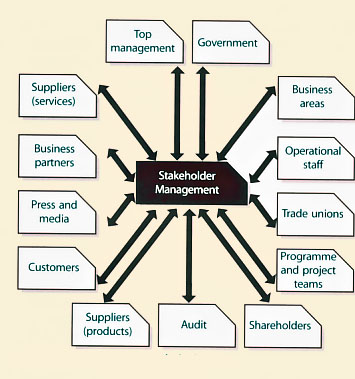
|
| Figure 5.5 Potential stakeholders |
It is helpful for Service Transition if stakeholders are listed under categories such as 'users/beneficiaries' or 'providers'. Each category can then be broken down further if necessary. Categories should be recognizable groups rather than abstract ones; for example, 'employees based in one geographical location' are a readily identifiable group, whereas 'members of the public who support human rights' are not. Some categories may identify the same individuals, but it is often useful to differentiate between stakeholders 'wearing different hats', such as those shown in Figure 5.5.
Examples of those who may be affected are:
| Stakeholders | Strategic direction | Financial | Operational changes | Interface with customers | Public safety | Competitive position |
| Business partner | ||||||
| Project teams | ||||||
| Customers | ||||||
| Press and media | ||||||
| Trade unions | ||||||
| Staff | ||||||
| Regulatory bodies | ||||||
| Figure 5.6 Example stakeholder map | ||||||
A stakeholder analysis helps to ensure that there is sufficient understanding of the stakeholder requirements and the stakeholder's interest in, and impact on, the change. Stakeholders' positions (in terms of influence and impact) may be rational and justifiable, or emotional and unfounded. However, they must all be taken into account since, by definition, stakeholders can affect the change process and hence the Service Transition. There is often a re-usable element of the stakeholder map and analysis. For example, where many projects are delivering into a shared service and infrastructure, the stakeholders may be the same: including the business sponsor, the Service Operations manager, the head of Service Management and the members of the Change Advisory Board.
The stakeholder analysis helps to ensure that communication channels are targeted appropriately and that messages, media and levels of detail reflect the needs of the relevant stakeholders. The communications channels may need to accommodate stakeholders who cannot be engaged directly with the Service Transition. In many cases, working through partners, industry groups, regulatory bodies, etc. may be required. Often one larger communication approach, covering all areas, can help deliver a consistent and stronger message than by operating at functional level.
One technique for analysing stakeholders is to consider each stakeholder in terms of their importance to Service Transition and the potential impact of the change on them and 'plot' them on a matrix (see Figure 5.7). This will guide the activities that Service Transition should adopt. For example, a business sponsor will have a 'high' status of importance to the overall service change, and, depending on the scale and opportunities for any return on their investment, the impact of the new or changed service may be 'low', 'medium' or 'high'. Stakeholders may move up or down the matrix as the service package progresses through the lifecycle, so it is important to revisit the stakeholder analysis work particularly during the detailed planning for Service Transition. Responsible stakeholders can and should enhance and even alter the course of the Service Transition.
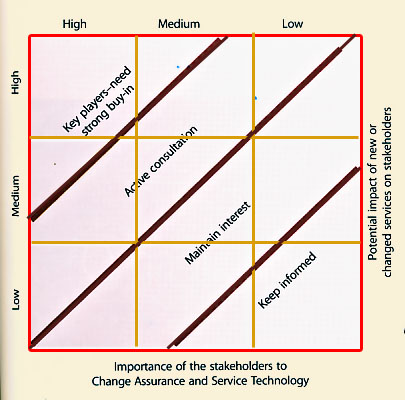
|
| Figure 5.7 Power impact matrix |
Some stakeholders will be able to participate in advisory or assurance roles; others will be important in assessing the realization of the benefits; others will have an audit perspective.
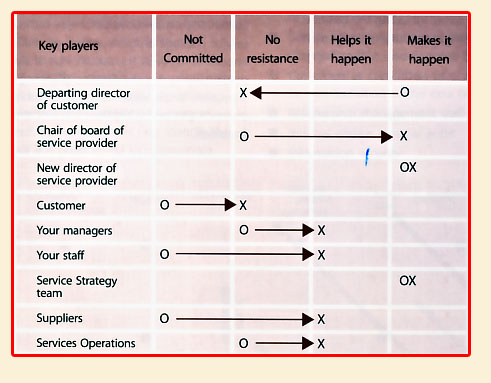
|
| Figure 5.8 Example commitment planning chart |
|
|
